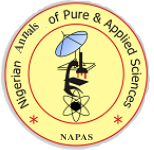Effect of Alchornea Cordifolia and Costus Afer based diet on Gut Microbes of Male Rabbits.
DOI:
Keywords:
Coliforms, Heterotrophic bacteria, Medicinal plants, Gut microbes, Phytobiotics, Rabbit microbiomeAbstract
The gut microbiome of animals affects the health and performance of the animal. This study was carried out to evaluate the effect of Alchornea cordifolia and Costus afer leaf meal on gut microbiome of young male rabbits. Twenty-four (24) 5-6 months old rabbit bucks with an average weight of 5.3kg were used for this study. The completely randomized design was used and the rabbit bucks were distributed into four (4) feeding /treatment groups (T) designated as T1 (the control fed with regular rabbit feed only), T2 (fed with Alchornea cordifolia), T3 (fed with Costus afer) and T4 (fed with a mixture of Alchornea cordifolia and Costus afer). The rabbits were fed the experimental diet for eight weeks and samples for microbiological analysis were collected from the different sections of the rabbit gut (stomach, ileum, caecum and colon) and droppings and analyzed for total heterotrophic bacteria (THB) and total coliform counts (TCC). The population density of THB was highest in T4 at the stomach (5.03±0.87 x 105 cfu/g) and ileum (5.32±1.19 x 105 cfu/g), but in T3 at the caecum (4.83±0.95 105 cfu/g), colon (4.15±0.60 x 105 cfu/g) and droppings (3.35±0.65 x 105 cfu/g. The population of TCC was highest in T4 in the stomach (i.e. 2.72±0.40 x 105 cfu/g) and ileum 2.67±0.53 x 105 cfu/g), in T3 at the caecum (3.53±0.69 x 105 cfu/g) and droppings (2.02±0.37 x 105 cfu/g, but T1 in the colon (2.77±0.60 x 105 cfu/g). The feed intake was highest in T4, followed by T3 and T1, but least in T2 (P <0.05), whereas there was no significant difference (P >0.05) in the weight gain of the rabbits (1.75 kg). We found that while Alchornea seemed to be reducing the population, Costus afer was enhancing their population and the overall effect on weight gain was insignificant
Downloads
Published
How to Cite
Issue
Section
License
Copyright (c) 2020 EI Ohimain, MB Nodu, OJ Imoni

This work is licensed under a Creative Commons Attribution-ShareAlike 4.0 International License.



 Contact Us
Contact Us Editorial Team
Editorial Team Join As A Reviewer
Join As A Reviewer  Request For Print Copy
Request For Print Copy


 Cprint Publishers
Cprint Publishers